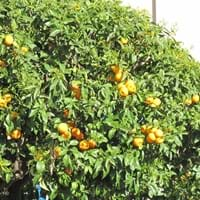Life Span
Perennial
Perennial
Type
Flowering Plants
Fruit
Origin
Italy, Southern Europe, western Balkans
Southeastern Asia, India, China
Types
not available
Not Available
Habitat
Islands, Not Available
Farms, Warmer regions
USDA Hardiness Zone
7-10
9-11
Sunset Zone
21,22
H1, H2, 8, 9, 12, 13, 14, 15, 16, 17, 18, 19, 20, 21, 22, 23, 24
Habit
Upright/Erect
Oval or Rounded
Flower Color
Lavender, Light Blue, White
White, Red, Purple
Flower Color Modifier
Bicolor
Bicolor
Fruit Color
Non Fruiting Plant
Orange
Leaf Color in Spring
Green, Light Green
Dark Green
Leaf Color in Summer
Green, Light Green
Dark Green
Leaf Color in Fall
Green, Light Green
Dark Green
Leaf Color in Winter
Light Green
Light Green
Leaf Shape
Compound
Ovate
Plant Season
Summer, Fall
Spring, Summer, Fall, Winter
Sunlight
Full Sun, Partial Sun
Full Sun
Growth Rate
Medium
Medium
Type of Soil
Loam
Loam, Sand
The pH of Soil
Acidic, Neutral
Acidic, Neutral, Alkaline
Soil Drainage
Average
Well drained
Bloom Time
Early Summer, Summer, Late Summer
Early Spring, Spring, Late Winter
Tolerances
Heat Tolerance
Drought
Where to Plant?
Ground, Pot
Ground
How to Plant?
From bulbs, Seedlings, Stem Planting
Seedlings
Plant Maintenance
Low
Medium
Watering Requirements
Average Water Needs, Do Not over Water, Never Over-water, Requires regular watering
Do not water frequently, Requires watering in the growing season, Water every two or three days during warmer months
In Summer
Lots of watering
Lots of watering
In Spring
Moderate
Moderate
In Winter
Average Water
Average Water
Soil pH
Acidic, Neutral
Acidic, Neutral, Alkaline
Soil Type
Loam
Loam, Sand
Soil Drainage Capacity
Average
Well drained
Sun Exposure
Full Sun, Partial Sun
Full Sun
Pruning
Remove damaged leaves, Remove dead branches, Remove dead leaves, Remove dead or diseased plant parts
Remove damaged leaves, Remove dead branches, Remove dead leaves
Fertilizers
fertilize every 2-3 weeks while growing, fertilize in growing season
All-Purpose Liquid Fertilizer
Pests and Diseases
fungus
Bacterial fruit blotch, Viruses
Plant Tolerance
Drought, Heat Tolerance
Drought
Flower Petal Number
Single
Single
Fragrant Bark/Stem
No
Yes
Showy Foliage
Not Available
No
Foliage Texture
Not Available
Medium
Foliage Sheen
Not Available
Glossy
Attracts
Birds, Insects
Birds, Butterflies
Allergy
Toxic
no allergic reactions
Aesthetic Uses
Beautification, Landscape Designing, Showy Purposes
Bonsai
Beauty Benefits
Not Available
Not Available
Environmental Uses
Air purification
Air purification
Medicinal Uses
Asthma, Cough, Unknown
Not Available
Part of Plant Used
Flowers, Leaves
Fruits
Other Uses
Decoration Purposes, Showy Purposes, Used as Ornamental plant
Cosmetics, Culinary use
Used As Indoor Plant
Yes
No
Used As Outdoor Plant
Yes
Yes
Garden Design
Mixed Border, Wildflower
Container, Edible, Feature Plant, Fruit / Fruit Tree, Mixed Border, Screening / Wind Break, Topiary / Bonsai / Espalier, Tropical
Botanical Name
CAMPANULA pyramidalis
CITRUS sinensis 'Washington'
Common Name
Chimney Bellflower
Navel Orange, Washington Navel Orange
In Hindi
Chimney Bellflower
संतरा
In German
Schornstein Glockenblume
Navel Orange
In French
cheminée Bellflower
Navel Orange
In Spanish
Chimenea Bellflower
Naranja de ombligo o «navel»
In Greek
καμινάδα καμπανούλα
Navel Orange
In Portuguese
chaminé Bellflower
Navel Orange
In Polish
komin Bellflower
Pomarańcza
In Latin
caminorum purgatores Bellflower
Apelsīns
Phylum
Tracheophyta
Magnoliophyta
Class
Magnoliopsida
Magnoliopsida
Order
Asterales
Sapindales
Family
Campanulaceae
Rutaceae
Clade
Angiosperms, Asterids, Eudicots
Angiosperms, Eudicots, Rosids
Tribe
Not Available
Citreae
Subfamily
Not Available
Not Available
Number of Species
Not Available
Not Available
Importance of Chimney Bellflower and Navel Orange
Want to have the most appropriate plant for your garden? You might want to know the importance of Chimney Bellflower and Navel Orange. Basically, these two plants vary in many aspects. Compare Chimney Bellflower and Navel Orange as they differ in many characteristics such as their life, care, benefits, facts, etc. Every gardener must at least have the slightest clue about the plants he wants to plant in his garden. Compare their benefits, which differ in many ways like facts and uses. The medicinal use of Chimney Bellflower is Asthma, Cough and Unknown whereas of Navel Orange is Not Available. Chimney Bellflower has beauty benefits as follows: Not Available while Navel Orange has beauty benefits as follows: Not Available.
Compare Facts of Chimney Bellflower vs Navel Orange
How to choose the best garden plant for your garden depending upon its facts? Here garden plant comparison will help you to solve this query. Compare the facts of Chimney Bellflower vs Navel Orange and know which one to choose. As garden plants have benefits and other uses, allergy is also a major drawback of plants for some people. Allergic reactions of Chimney Bellflower are Toxic whereas of Navel Orange have no allergic reactions respectively. Having a fruit bearing plant in your garden can be a plus point of your garden. Chimney Bellflower has no showy fruits and Navel Orange has showy fruits. Also Chimney Bellflower is not flowering and Navel Orange is not flowering . You can compare Chimney Bellflower and Navel Orange facts and facts of other plants too.





